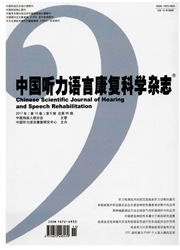

 中文摘要:
中文摘要:
目的构建携带c—myc基因的重组腺病毒表达载体,并观察其在豚鼠耳蜗内的表达分布,为探讨该基因的功能奠定实验基础。方法利用细菌内同源重组的方法,构建携带c—myc基因的重组腺病毒表达载体(Ad.c--myc--EGFP),并分别应用酶切、逆转录聚合酶链反应(RT--PCR)和测序方法鉴定腺病毒的构建情况。利用豚鼠耳蜗内显微注射术、Westernblot及荧光显微镜观察注射后该蛋白在耳蜗中的表达及分布特性。结果经酶切、RT--PCR和测序鉴定,质粒构建正确,重组腺病毒Ad.c--myc--EGFP构建成功。Ad.cmmyc--EGFP腺病毒豚鼠耳蜗内注射后第三天便可通过荧光显微镜观察到绿色荧光蛋白的广泛分布,且WesternBlot方法证实它可以上调耳蜗内c-Myc蛋白的表达。结论本实验成功构建了携带c—myc基因的重组腺病毒表达载体,它可以有效地感染豚鼠耳蜗内各种细胞,为深入研究c—myc基因在耳蜗中的作用奠定了实验基础。
 英文摘要:
英文摘要:
Objective To construct the adenoviral vector carrying c-myc gene and to study the expression of this gene in the cochleae of guinea pigs. Methods The recombinant adenoviral vector carrying the c-myc gene (Ad.c-myc-EGFP) was constructed by homologous recombination in bacteria, and then identified by restriction enzymes and RT-PCR. After Ad. c-myc-EGFP was transferred into the cochleae of guinea pigs, its expression was observed by fluorescence microscopy and detected by Western blot method. Results The recombinant adenoviral vector * carrying c-myc gene was constructed and confirmed by restriction enzyme analysis and RT-PCR. Three days after the inoculation of adenoviral vectors, green fluorescence would be observed in the cochleae, and a single c-Myc band was observed by western blot in the Ad.c-myc-EGFP group. Conclusion The Ad.c-myc-EGFP vector is successfully established and can express efficiently in various cells of cochleae, which lays the foundation for the further research on c-rnyc gene's function in the cochleae.
 同期刊论文项目
同期刊论文项目
 同项目期刊论文
同项目期刊论文
 Up-regulation of stromal cell-derived factor-1 enhances migration oftransplanted neural stem cells t
Up-regulation of stromal cell-derived factor-1 enhances migration oftransplanted neural stem cells t Acoustical Stimulus Changes the Expression of Stromal Cell-Derived Factor-1 in the Spiral Ganglion N
Acoustical Stimulus Changes the Expression of Stromal Cell-Derived Factor-1 in the Spiral Ganglion N Wnt1 from Cochlear Schwann Cells Enhances Neuronal Differentiation of Transplanted Neural Stem Cells
Wnt1 from Cochlear Schwann Cells Enhances Neuronal Differentiation of Transplanted Neural Stem Cells Expression and localization of atrial natriuretic peptide and its receptors in rat spiral ganglion n
Expression and localization of atrial natriuretic peptide and its receptors in rat spiral ganglion n Stem cell transplantation via the cochlear lateral wall for replacement of degenerated spiral gangli
Stem cell transplantation via the cochlear lateral wall for replacement of degenerated spiral gangli Dynamic changes in microRNA expression during differentiation of rat cochlear progenitor cells in vi
Dynamic changes in microRNA expression during differentiation of rat cochlear progenitor cells in vi A comparison of the proliferative capacity and ultrastructure of proliferative cells from the cochle
A comparison of the proliferative capacity and ultrastructure of proliferative cells from the cochle Combined use of decellularized allogeneic artery conduits with autologous transdifferentiated adipos
Combined use of decellularized allogeneic artery conduits with autologous transdifferentiated adipos 期刊信息
期刊信息
